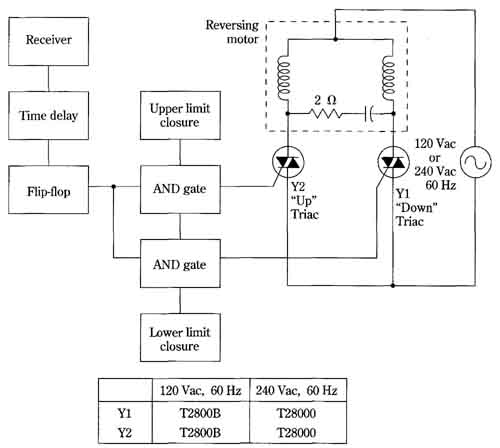AMAZON multi-meters discounts AMAZON oscilloscope discounts
. Figure 2 illustrates a simple, but reliable, technique for reversing the motor that actuates electronic garage door openers. The motor used is a permanent-capacitor induction type. Such a single-phase machine is admirably suited to this application. Rotation occurs in one direction when the first triac is turned on, and in the reverse direction when the alternate triac is turned on. Because of the full-wave conduction characteristic of triacs, it’s as if a switch were closed when either triac is triggered into its conductive state. The physical nature of the system precludes the possibility of both triacs conducting simultaneously.

FIG. 2 Motor-reversing technique for garage door systems. based on RCA design.
Various other motors have been used for garage door openers. These include capacitor-start and resistance-start split-phase types, as well as repulsion and repulsion-induction motors. However, the permanent-capacitor motor is best adapted to the simple triac circuit of FIG. 2. The capacitor size can be somewhat larger than normal so that starting torque will be increased. There are also split-field universal motors available that will operate with this scheme (it is not always considered good practice to use this type of motor in a belt-driven system, although most 1 or 1 units won’t race to destruction in the event that the belt is lost).
Garage door openers have features not evident from the motor-control circuit in FIG. 2. In order to avoid actuation from other transmitters, the UHF or VHF signal is usually tone modulated. Selective resonant circuits associated with the receiver then respond only to the intended transmitter. Mechanical devices disengage or re verse the drive mechanism in the event that an object impedes the motion of the door. This prevents injury to children or animals. A light usually remains on for about two minutes after the door is opened or closed. These features don’t make any imposition on the motor, however.